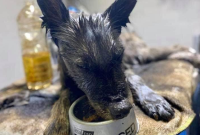On April 26, 1986, the Chernobyl disaster occurred in Ukraine, when a serious technical fault in the Chernobyl nuclear power plant resulted in the explosion of one of the nuclear reactors. This incident created a large exclusion zone due to radiation and the animals had to face starvation and adverse effects from radiation. But in the midst of this terrifying scene, a dog became the center of attention.

One day, a group of researchers was conducting studies on the impact of the Chernobyl disaster on animals. As they were approaching the restricted area, they heard a pitiful cry in the distance. They were fascinated by this sound and decided to investigate.
After hours of being helpless, they found a dog with serious injuries, blurred vision and emaciated body. However, the most surprising thing is that the dog not only has a patient heart, but also has the ability to speak a few words of Russian. It was hurt and scared, but it was strong enough to mutter “Help me” in Russian.
The story of this dog spread widely and attracted the attention of the international community. With this discovery, scientists began to study the language ability of dogs and the possibility of radiation effects on them.
Scientists carried out a series of experiments to find out if radiation exposure affects a dog’s ability to learn language. The results show that dogs have the ability to learn and use human language. They can recognize and react to words and even short sentences through training and human interaction. This development opened a new field in the study of animal language.

Another aspect of this study is the impact of radiation on the health of dogs. Scientists have found that radiation has caused many negative effects on the body of dogs. They have vision problems, weakened immune systems and reproductive problems. This shows the profound impact of a nuclear disaster not only on humans but also on other living things.
However, the story of the dog from the Chernobyl disaster site also offers a hope for recovery. Animal welfare organizations and philanthropists have joined together to save dogs and other animals from radioactive contamination. Efforts such as fostering, medical care and finding new homes for them have been launched. As a result, some dogs have found new homes and are lovingly raised.


In the years following the Chernobyl disaster, research into the effects of radiation on animals continued. Scientists have gathered important data and information from observing animals living in radioactive areas. These findings give us more insight into the impact of nuclear disasters and also raise questions about the management and protection of the environment.
Simultaneous media has played an important role in creating awareness about the status of animals in radioactive environments. The story of the dog from the Chernobyl disaster area has been widely disseminated in the media, from newspapers to social networks, creating interest and spreading the message about protecting the environment and the environment. animals.
In conclusion, the story of the dog from the Chernobyl disaster site opened up a whole new set of studies and created sensitivities about the effects of radiation on animals. Dogs are not only man’s loyal friend, but also a surprising phenomenon with their ability to learn human language and tolerance in radioactive environments. This story has also awakened our sense of protecting the environment and respecting the lives of other animals.


